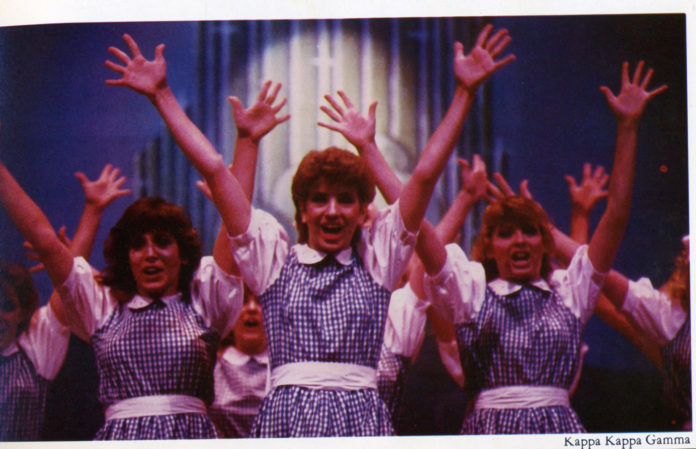By Olivia Turner | Staff Writer
Baylor’s ever-famous All-University Sing has changed tremendously through the years. From the small singing-and-dancing acts proposed by Mary Wiley Mathis, the creator of Sing, to the Broadway-level productions of the present, there’s one thing that hasn’t changed — a steadfast tradition among Baylor’s list of annual events to look forward to.
According to Baylor alumna and former Kappa Kappa Gamma Sing chair Rene Taylor, the glamour and grandeur of current Sing acts owe it all the originals.
“I absolutely believe that we are all standing on the shoulders of the first people who started all this,” Taylor said.
From 1984 to 1985, Taylor served as one of the Sing chairs for Kappa Kappa Gamma where she mainly directed choreography. In order to rehearse the athletic and often elaborate routines, Taylor said they needed plenty of space and the small chapter rooms at the time could not provide for the groups.
Before the Stacy Riddle Panhellenic Building was built in 2003, Taylor and her fellow Sing members would have to meet at other locations, sometimes landing in activity centers of churches, cafeterias of local schools or warehouses across La Salle Avenue. These places needed to be secluded enough from the university to be able to ensure the element of mystery required by the tradition for all groups, a task which alumna and former Zeta Tau Alpha Sing member Amy Ellis said she found especially difficult.
Ellis said she can recall her group using a Cadillac dealership called Rountree in downtown Waco for their practice space in the late ‘90s.
“They moved the cars out of the lobby of the car dealership, and that’s where we practiced all the years I was there,” Ellis said.
Ellis said coordinating the meetups was also tricky due to the lack of group texts current groups are blessed with. Scheduling required participants to be on their A-game, she said.
Taylor said another way phones contribute to modern Sing success is through the lens of the phone camera. She said without the ability to view recordings of the act while practicing, there was no way to tell how it looked to the eye of the audience. To work through the issue, she said she would have participants step out on certain run-throughs to see how it looked.
There was another angle of aesthetics Taylor said was important to consider when practicing: lighting. Unfortunately for Taylor and her sorority sisters, there was no way to be able to get a feel for how to use the technology without access to a theater.
“Lighting is an art form,” Taylor said. “Understanding how the light should expand up or go down to create the mood or go along with your act, that was where we really fell short because we really did not
understand that.”
Taylor said in addition to visuals, there was sound to be considered. Projection, energy and volume were all essentials to being able to create a booming experience for the audience. Extra effort in this area was necessary due to the unreliability of the microphones, Taylor said.
“We laughed about getting the Madonna mics,” Taylor said as she chuckled. “The chances of a soloist’s mic not working was literally 50/50.”
In light of the challenges of Sing during the ‘80s and ‘90s, some rules have become even more strict, Taylor said. She said when she performed when she was chair, there were unlimited hours for the groups to practice their pieces. Now, Sing groups are only allowed to practice for 14 hours a week.
Despite the challenges, she found a great thrill in performing. Taylor said she thoroughly enjoyed singing and dancing in front of an audience, and Ellis said her experience was similar.
“To hear the audience cheering and even certain people cheering on performers by name, just getting really excited to show off your hard work,” Ellis said.
When looking back on the Sing acts of the ‘80s and ‘90s, Taylor said she has seen tremendous changes since her days in the spotlight, which have left her
overwhelmingly impressed.
“It just keeps evolving with the talent and the experience that comes in,” Taylor said. “I am so blown away at how incredible the club performances are. And the singing and the talent — wow, it’s crazy to me!”






